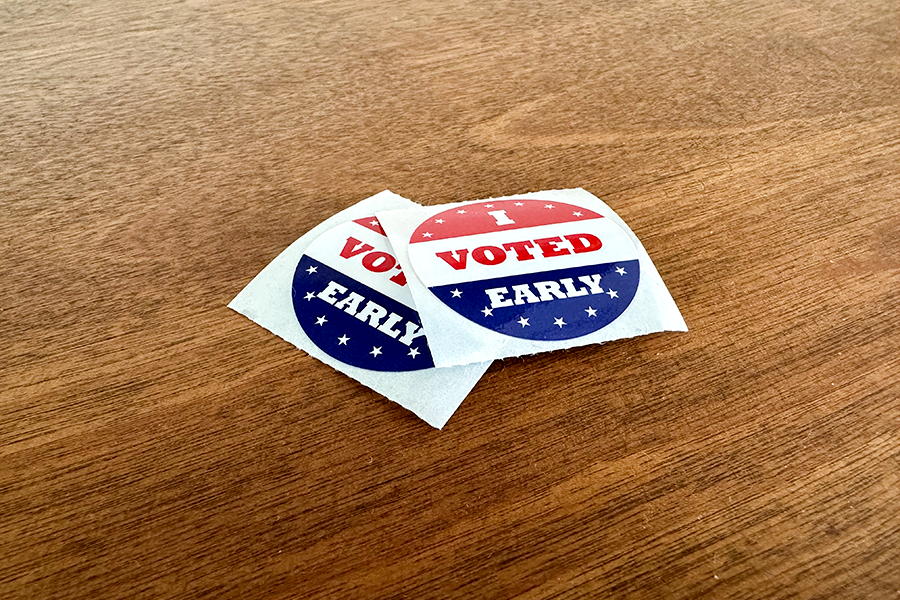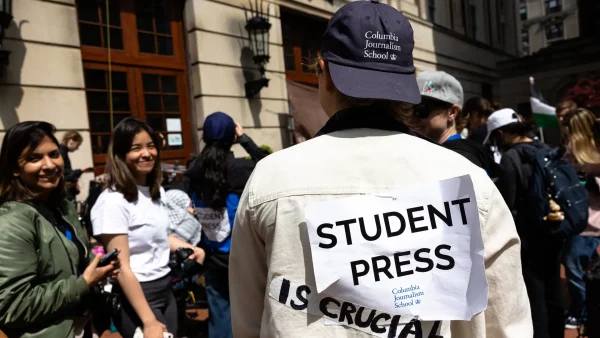Winter bicycling deserves to be taken seriously
Senior Ingrid Noren heads to school in February. She recommends winter biking, saying that “it’s better for your health [and] better for the planet.”
March 6, 2023
In the warm months, South’s bike racks are usually full. In the wintertime, however, they’re nearly empty. When it gets cold, students who regularly bike to school in warm weather often opt to drive, carpool, or take public transportation instead. They might be dissuaded from bicycling by poor road conditions, temperatures that seem prohibitively cold, or just peer pressure. But bicycles don’t deserve to be put away when the thermometer drops below freezing. Winter bicycling is an eco-friendly, accessible, and even enjoyable way to get around.
In recent years, young people have become increasingly concerned and increasingly active about the effects of climate change. But the same people attending climate rallies at the Capitol and condemning corporate emissions often end up jockeying for parking spots around school. Driving in the winter is comfortable, convenient, and entirely understandable – no one should be judged for choosing to drive in January windchills. However, reexamining our societal relationship with motor vehicles is part of addressing our impact on the climate and on the city we live in. A typical car runs on fossil fuels and emits several metric tons of carbon dioxide each year. Highways, built exclusively for cars, have divided Minneapolis neighborhoods and exacerbated inequities between them. These problems don’t go away in winter, although driving a car becomes more appealing in the colder months. Bicycling deserves to be considered as an alternative, even when it requires bundling up. Is the trouble of winter bicycling worth it? A few members of the South community still show up to the bike racks in winter, and they think so.
Senior Ingrid Noren bikes to school year-round, and speaks highly of her experiences: “It’s better for your health, better for the planet, and I really recommend it.” Photography and design teacher Corbin Doty describes winter as “always more beautiful than you realize,” and says that winter bicycling is a chance to “[see] the world from a different level.” Winter bicycling offers both tangible and intangible benefits. For students with busy schedules, a bike commute is a chance to exercise on the way to and from school. Senior Amelie Steer says that “It is nice to force myself to move my body in the morning… I don’t exactly want to go out in the cold and bike, but afterwards it feels good.” Steer also points out that bicycling is “cost effective, because it costs less than public transportation.” During a season when the weather is often gray and daylight can be scarce, bicycling also offers an emotional boost. Noren says that, “if I don’t get outside before spending seven hours in a dark school building, I get a little sad.”
Having the right gear for bicycling in winter is more important than in other seasons, but gear shouldn’t be seen as a barrier to winter bicycling. “Having a warm pair of mittens, and layering ski masks, really helps,” says Doty, “but most of it’s not expensive stuff.” Experience – and layering – can make even the coldest temperatures possible to bike in. Noren says that, “with biking, I get really in tune to what I need to wear… biking in negative ten degrees is really something.” Studded tires are one piece of winter gear that can cost more, but according to Steer, “It’s definitely worth making the investment, because if you’re biking without studded tires, it’s going to be miserable to you.” Doty says that when he first started bicycling in winter, “Studded tires weren’t really a thing… but they really help.” With the gear available now, winter bicycling is continuing to become easier and more accessible.
Winter bicycling isn’t a fringe activity for a tough and principled few, but a viable mode of transportation and alternative to driving a car. It’s already possible to enjoy bicycling in the wintertime. However, conditions for winter bicyclists could improve substantially if the city of Minneapolis were to recognize and prioritize people who bike in the winter.
During three seasons of the year, Minneapolis touts itself as a city that prioritizes and promotes bicycling as a healthy, community-centered, and environmentally friendly mode of transportation. But in the winter, bicyclists are suddenly treated as though they don’t exist. Snow is often plowed into parking lanes, causing cars to park in bike lanes. This forces bicyclists either to bike in the main road with car traffic, or to find an alternate route. Additionally, a road that’s adequately plowed for cars can still be nearly impossible to bike on, if there are deep ruts or slushy, semi-packed snow. Busy arterial roads are typically plowed most thoroughly and have the best surface condition, but can feel dangerous to bike on due to higher vehicle speeds and more car traffic, especially when bike lanes are blocked by parked cars. Quieter side streets are often left with a surface covering of snow, which makes bicycling difficult.
This winter in particular, the road conditions have been notably poor as Minneapolis plow services struggle to keep up with heavy snowfalls. According to Doty, “We’re in the midst of a steep decline of the snow removal abilities of the city.” Noren notes that snow has accumulated more quickly on streets this year than in the past, saying that “A lot of the time, I don’t really have to bike through snow until January, but there was a lot in December this year.” Some streets – particularly side streets that have less car traffic, and are safer for bicyclists – haven’t been plowed at all after a snowfall. On these streets, cars eventually pack the snow down into a driveable surface, but the snow is often still loose enough to cause bicycles to fishtail. While it can be difficult to drive on poorly plowed streets, it’s even more difficult to bike. The city’s current plowing practices don’t necessarily indicate that bicyclists are being actively sidelined. In reality, however, their effect is that a dangerous and environmentally harmful form of transportation – driving – is encouraged, while bicycling is discouraged. Roads aren’t being plowed with bicyclists in mind, because car traffic is treated as the default.
There are certain bike routes in Minneapolis where cars aren’t treated as the default, because there aren’t any. Bike paths like the East and West River Parkways and the Midtown Greenway offer a place to bicycle separate from car traffic and parallel to major roads. In summer, they experience steady bicycle traffic. In winter, they’re beset with the same plowing problems that regular streets are. Steer says that on her bike ride to school, the bike paths “are plowed but not well, so usually I’m biking through snow or slush, which definitely makes the ride slower.” Plowing bike paths more effectively would be a great step toward making winter bicycling a better experience. It’s obvious, though, that having good bike paths is not enough for bicyclists to get around easily and safely, because most places can’t be accessed by path. For more people to try bicycling in the winter, it’s crucial that Minneapolis treats all its streets as bikeways akin to its dedicated bike paths, and recognizes that cars are not the only vehicles on streets.
Bicycles are some of the simplest vehicles around, but they’re the transportation of the future. They’re not only affordable and environmentally friendly, they also promote healthy and livable communities. Bicyclists deserve safe streets where they can get around easily and enjoy the ride, in every season.

![Senior Ingrid Noren heads to school in February. She recommends winter biking, saying that “it’s better for your health [and] better for the planet.”](https://www.shsoutherner.net/wp-content/uploads/2023/03/Winter-biking-900x675.jpg)




